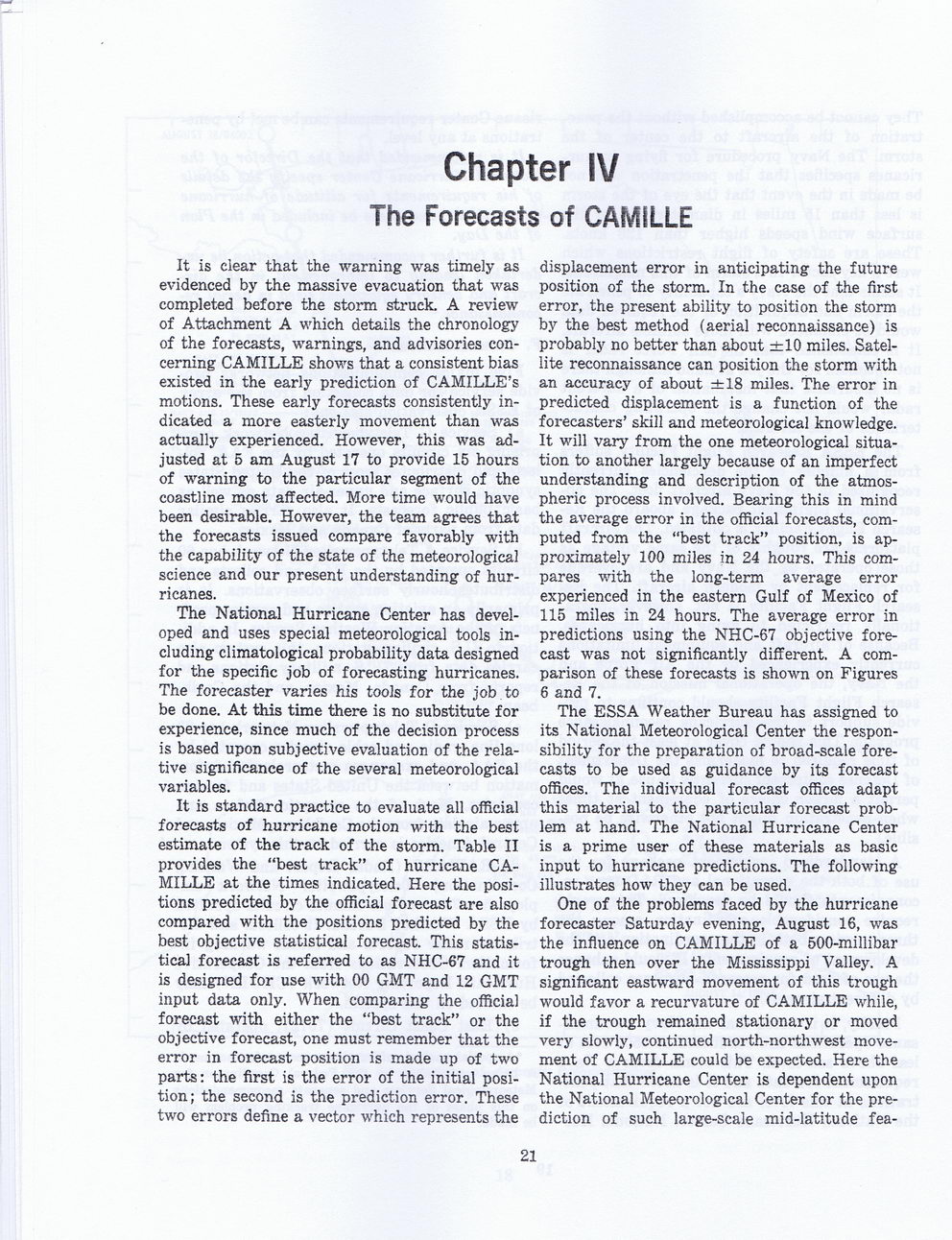This text was obtained via automated optical character recognition.
It has not been edited and may therefore contain several errors.
Chapter IV The Forecasts of CAMILLE It is clear that the warning was timely as evidenced by the massive evacuation that was completed before the storm struck. A review of Attachment A which details the chronology of the forecasts, warnings, and advisories concerning CAMILLE shows that a consistent bias existed in the early prediction of CAMILLE’s motions. These early forecasts consistently indicated a more easterly movement than was actually experienced. However, this was adjusted at 5 am August 17 to provide 15 hours of warning to the particular segment of the coastline most affected. More time would have been desirable. However, the team agrees that the forecasts issued compare favorably with the capability of the state of the meteorological science and our present understanding of hurricanes. The National Hurricane Center has developed and uses special meteorological tools including climatological probability data designed for the specific job of forecasting hurricanes. The forecaster varies his tools for the job to be done. At this time there is no substitute for experience, since much of the decision process is based upon subjective evaluation of the relative significance of the several meteorological variables. It is standard practice to evaluate all official forecasts of hurricane motion with the best estimate of the track of the storm. Table II provides the “best track” of hurricane CAMILLE at the times indicated. Here the positions predicted by the official forecast are also compared with the positions predicted by the best objective statistical forecast. This statistical forecast is referred to as NHC-67 and it is designed for use with 00 GMT and 12 GMT input data only. When comparing the official forecast with either the “best track” or the objective forecast, one must remember that the error in forecast position is made up of two parts: the first is the error of the initial position; the second is the prediction error. These two errors define a vector which represents the displacement error in anticipating the future position of the storm. In the case of the first error, the present ability to position the storm by the best method (aerial reconnaissance) is probably no better than about ±10 miles. Satellite reconnaissance can position the storm with an accuracy of about ±18 miles. The error in predicted displacement is a function of the forecasters’ skill and meteorological knowledge. It will vary from the one meteorological situation to another largely because of an imperfect understanding and description of the atmospheric process involved. Bearing this in mind the average error in the official forecasts, computed from the “best track” position, is approximately 100 miles in 24 hours. This compares with the long-term average error experienced in the eastern Gulf of Mexico of 115 miles in 24 hours. The average error in predictions using the NHC-67 objective forecast was not significantly different. A comparison of these forecasts is shown on Figures 6 and 7. The ESSA Weather Bureau has assigned to its National Meteorological Center the responsibility for the preparation of broad-scale forecasts to be used as guidance by its forecast offices. The individual forecast offices adapt this material to the particular forecast problem at hand. The National Hurricane Center is a prime user of these materials as basic input to hurricane predictions. The following illustrates how they can be used. One of the problems faced by the hurricane forecaster Saturday evening, August 16, was the influence on CAMILLE of a 500-millibar trough then over the Mississippi Valley. A significant eastward movement of this trough would favor a recurvature of CAMILLE while, if the trough remained stationary or moved very slowly, continued north-northwest movement of CAMILLE could be expected. Here the National Hurricane Center is dependent upon the National Meteorological Center for the prediction of such large-scale mid-latitude fea- 21

Historic Hurricanes (Treutel Book) Historic-Hurricanes-Of-Hancock-County-1812-2012-(126)